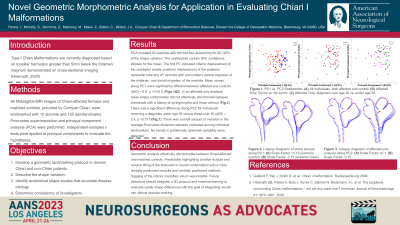Novel Geometric Morphometric Analysis for Application in Evaluating Chiari I Malformations
Friday, April 21, 2023

Has Audio
.jpg)
Ishan R. Perera (he/him/his)
OMS-II
Edward Via College of Osteopathic Medicine - VA Campus
Norfolk, Virginia, United States
ePoster Presenter(s)
Introduction: Chiari malformation is typically defined as inferior descent of the cerebellar tonsils through the foramen magnum. Recent investigations attempting to characterize Chiari I malformation have included exhaustive collection of linear dimensions and angles in the midsagittal plane. The primary aim of this study is to describe midbrain and hindbrain shape using geometric morphometric techniques.
Methods: Midsagittal MRI images from 94 Chiari-affected females and matched controls were landmarked using tpsDig264 (v.2.32) and tpsUtil64 (v.1.82). A total of 10 discrete and 155 semilandmarks were placed on features of the midbrain and hindbrain. Generalized Procrustes superimposition and principal component analysis (PCA) were applied to the results using MorphoJ (v.1.07a). Independent-samples t-tests were applied to principal component (PC) scores to evaluate hypotheses related to configurational differences between groups. Past (v.4.03) and MorphoJ were used to visualize results.
Results: The PCA revealed 93 loadings with the first four accounting for 65.126% of the overall variation in the shape. The first PC indicated inferior displacement of the cerebellar tonsils, posterior displacement of the posterior cerebellar lobe and 4th ventricle with concomitant ventral migration of the midbrain, and dorsal migration of the medulla. Mean scores along PC1 were significantly different between affected and control groups (t(93) = 6.8, p < 0.001). In an affected-only analysis, mean shape conformation did not effectively discriminate between individuals with a history of syringomyelia and those without. There was a significant difference along PC2 for individuals receiving a diagnosis under age 30 versus those over age 30 (t(65) = 2.4, p =0.017).
Conclusion : Geometric analysis effectively discriminates between Chiari-affected individuals and matched controls. Aside from predictably highlighting tonsillar ectopia, results demonstrated a number of additional anatomical conformations in individuals with Chiari I malformation. Future directions should include machine learning to evaluate subtle shape differences between groups with the goal of integrating results into clinical decision-making.
Methods: Midsagittal MRI images from 94 Chiari-affected females and matched controls were landmarked using tpsDig264 (v.2.32) and tpsUtil64 (v.1.82). A total of 10 discrete and 155 semilandmarks were placed on features of the midbrain and hindbrain. Generalized Procrustes superimposition and principal component analysis (PCA) were applied to the results using MorphoJ (v.1.07a). Independent-samples t-tests were applied to principal component (PC) scores to evaluate hypotheses related to configurational differences between groups. Past (v.4.03) and MorphoJ were used to visualize results.
Results: The PCA revealed 93 loadings with the first four accounting for 65.126% of the overall variation in the shape. The first PC indicated inferior displacement of the cerebellar tonsils, posterior displacement of the posterior cerebellar lobe and 4th ventricle with concomitant ventral migration of the midbrain, and dorsal migration of the medulla. Mean scores along PC1 were significantly different between affected and control groups (t(93) = 6.8, p < 0.001). In an affected-only analysis, mean shape conformation did not effectively discriminate between individuals with a history of syringomyelia and those without. There was a significant difference along PC2 for individuals receiving a diagnosis under age 30 versus those over age 30 (t(65) = 2.4, p =0.017).
Conclusion : Geometric analysis effectively discriminates between Chiari-affected individuals and matched controls. Aside from predictably highlighting tonsillar ectopia, results demonstrated a number of additional anatomical conformations in individuals with Chiari I malformation. Future directions should include machine learning to evaluate subtle shape differences between groups with the goal of integrating results into clinical decision-making.
